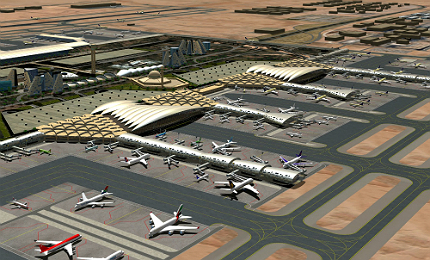
Located 35km north of Saudi Arabia's capital city Riyadh, King Khaled International Airport was designed by the US-based architecture-engineering firm Hellmuth, Obata and Kassabaum (HOK).
When the airport opened in 1983, it become the largest in the world in terms of ground area - originally covering some 225km² - only to be trumped by another Saudi Arabian airport; Dammam's King Fahd International, in 1999.
With a total of four terminals, one of the world's tallest air control towers, a mosque and two parallel runways each 4,200m long, King Khaled Airport serves as the gateway to Saudi Arabia's largest city.
Design of King Khaled International Airport
"Saudi Arabia hopes to have a combined future capacity of 140 million passengers each year."
King Khaled Airport is designed with all four terminals within one main building, which are connected to each other by three linking buildings - each of which measures 168m in length.
Each of the triangular-shaped terminals has eight gates, which all have air bridges installed to eradicate any need for bus journeys between the terminal buildings and waiting aircrafts. The triangular base of each terminal measures 47,500m².
The airport is currently operated by the international airport management company Fraport AG, which is most famously known for managing Frankfurt Airport.
King Khaled International Airport has witnessed a steady increase in passengers during the last decade. In 1998, it handled just more than eight million passengers and had about 60,000 aircraft movements. By 2003, this figure had almost doubled to more than 14 million passengers and 124,516 aircraft movements. The airport handled 14.88 million passengers (9.4% increase compared to previous year) and 135,757 aircraft movements in 2011.
Terminals of the Saudi Arabian airport
Of King Khaled's four terminals, two are currently used for international flights, one for domestic routes and the other remains unused.
Terminal 1 is used for international flights by a number of major airlines, including Air France, Air India, Emirates, Etihad Airways, Lufthansa, Qatar Airways and Singapore Airlines.
Terminal 2 is for the sole use of Saudi Arabia's national carrier - Saudi Arabian Airlines. It operates to destinations including Abu Dhabi, Athens, Delhi, Dubai, Frankfurt, Johannesburg, London, Paris, New York and Singapore.
Terminal 3 is used for domestic flights, predominantly by Saudi Arabian Airlines, but also by low-cost carriers such as Nas Air and Sama Airlines.
The terminal complex also includes restaurants, airline offices, government departments, hotels, banks commercial shops and a modern VIP terminal. Heads of state or other high ranking VIP visitors are greeted in the Royal Pavilion, which comes complete with fountains, garden areas and a 12.5m-wide ceremonial hall.
Additionally, a general aviation complex has been constructed north of the first runway for use by private aircraft, which can be reached by a special access road that runs from the airport access highways. The complex includes a passenger terminal, aircraft parking and maintenance facilities.
Distinctive features at King Khaled airport
King Khaled Airport possesses one of the world's tallest air control traffic towers. Standing 81m high, the tower has 19 separate storeys - including an operations area on its base level that has a total of 1,230m² of floor space.
One of the airport's most defining features is a mosque located in the centre of the passenger terminal. Capable of accommodating 5,000 worshippers inside and another 5,000 in its outside plaza, the mosque has a dome measuring 33m in diameter and several towers that measure 44m above the arrivals level roadway.
Also notable is the airport's 500,000m² of landscaping, which includes more than 225,000 trees, vines, shrubs and ground cover plants. All the plants selected for the site are tolerant to the region's arid climate.
Future developments at IATA: RUH
In August 2008, the Kingdom of Saudi Arabia's General Authority of Civil Aviation (GACA) signed a consultancy contract with Netherlands Airports Consultants BV (NACO). The Dutch airport consultancy firm, which has been present in the Kingdom for 40 years, has been employed to help determine the technical and strategic guidelines for future improvements at both King Khaled Airport and King Fahd International Airport in Dammam.
"King Khaled Airport serves as the gateway to Saudi Arabia's largest city."
The plan involves increasing the capacity at the airport from its current capacity of 14 million passengers a year to about 40 million passengers by 2038. It is part of the Kingdom's much broader goal of becoming a major aviation gateway for both domestic and international demand.
In January 2013, global architect HOK and NACO's Saudi Arabian branch SADECO were awarded a design build contract for expansion of terminals 3 and 4 of the airport. This expansion is being made to increase the airport's capacity to handle 20 to 25 million passengers a year. The expansion is expected to cost $800m and is scheduled to be completed by 2015.
In March 2013, a joint venture between AECOM Technology Corporation and other partners was awarded a $72m five-year contract for the expansion of the terminals. AECOM will provide programme support, project and construction management services under the contract.
By expanding its three major airports in Damman, Jeddah and Riyadh, Saudi Arabia hopes to have a combined future capacity of 140 million passengers each year, to support its rapidly expanding population and oil-strong economy.